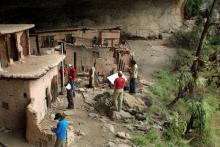The Xiximes numbered 5,000 at their tribe’s height and believed that ingesting the bodies and souls of their kind would improve the fertility of their corn harvest in the coming year. A recent analysis of over three dozens human bones confirms evidence of defleshing and boiling. They would then use the bones, carved ritualistically, for ceremonies. An archeologist behind the new study told National Geographic that, “that cannibalism was a crucial aspect of their worldview, their identity.” Although there has never been any physical evidence to prove cannibalism among the neighboring Acaxees, the cultural similarities and Jesuit accounts provide good circumstantial evidence. Although the Xiximes and Acaxees would fight and kill other indigenous groups, even invading Spaniards, they would only eat their own kind. “Other native groups and Spanish colonizers were apparently ritually worthless, according to historical studies.”
In the Cueva Del Maguey, a small collection of hovels within a cliffside cave, a deposit of bones have given scientists ample evidence in confirming the Jesuit reports. Scientists found that 80% of the bones, found with the small houses, which dated back to 1425 AD, bear marks of either having been boiled or cut with blades made of stone. The bones have been relatively untouched for centuries, giving scientists high degrees of certainty in their tests.
The Xiximes people enacted the circle of life with bloody results. After each corn harvest, the Xiximes warriors would be dispatched into the forests. At times they would “hunt” and kill lone men working in fields or traveling along paths. Other times there would be small forest skirmishes with other villages and victims would be brought back to be ritually butchered. According to the studies, researchers believe that warriors would physically break the bodies apart, it being too impractical to transport them whole. After the bodies were flayed and boiled, the bones would be stored until the beginning of the next harvest season, when the Xiximes would hang them from doorways and roofs to entice spirits to help the corn grow.
